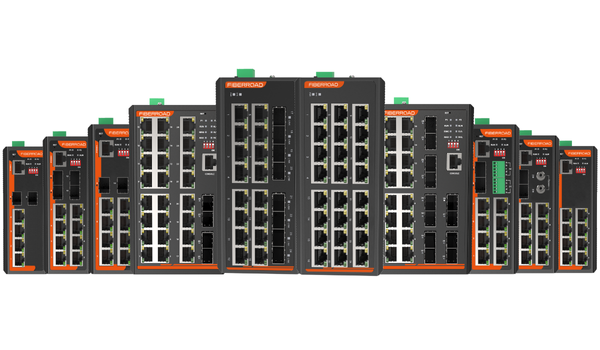Industrial Ethernet Glossary
Industrial Ethernet communication Protocols
Ethernet is becoming ubiquitous and cost-effective, with common physical links and increased speed. As such, many industrial communication protocols are moving to Ethernet-based solutions. Ethernet communications with TCP/IP typically are non-deterministic, and reaction time is often around 100 ms. Industrial Ethernet protocols use a modified Media Access Control (MAC) layer to achieve very low latency and deterministic responses. Ethernet also enables a flexible network topology and a flexible number of nodes in the system. Let’s look at some of the popular Industrial Ethernet protocols in detail.
EtherCAT, a protocol optimized for process data, uses standard IEEE 802.3 Ethernet Frames. Each slave node processes its datagram and inserts the new data into the frame while each frame is passing through. The process is handled in hardware so each node introduces minimum processing latency, enabling the fastest possible response time. EtherCAT is the MAC layer protocol and is transparent to any higher-level Ethernet protocols such as TCP/IP, UDP, Web server, etc. EtherCAT can connect up to 65,535 nodes in a system, and EtherCAT master can be a standard Ethernet controller, thus simplifying the network configuration. Due to the low latency of each agent node, EtherCAT delivers flexible, low-cost and network-compatible industrial Ethernet solutions.
EtherNet/IP is an application-layer protocol on top of TCP/IP. EtherNet/IP uses standard Ethernet physical, data link, network and transport layers while using Common Industrial Protocol (CIP) over TCP/IP. CIP provides a standard set of messages and services for industrial automation control systems, and it can be used in multiple physical media. For example, CIP over CAN bus is called DeviceNet, CIP over the dedicated network is called ControlNet and CIP over Ethernet is called EtherNet/IP. EtherNet/IP establishes communication from one application node to another through CIP connections over a TCP connection, and multiple CIP connections can be established over one TCP connection.
PROFINET is a widely used industrial Ethernet by major industrial equipment manufacturers such as Siemens and GE. It has three different classes. PROFINET Class A provides access to a PROFIBUS network through a proxy, bridging Ethernet and PROFIBUS with a remote procedure calling on TCP/IP. Its cycle time is around 100 ms, and it is
mostly used for parameter data and cyclic I/O. The typical application includes infrastructure and building automation. PROFINET Class B, also referred as PROFINET Real-Time (PROFINET RT), introduces a software-based real-time approach and has reduced the cycle time to around 10 ms. Class B is typically used in factory automation and process automation. PROFINET Class C (PROFINET IRT), is Isochronous and real-time, requiring special hardware to reduce the cycle time to less than 1ms to deliver sufficient performance on the real-time industrial Ethernet for motion control operations. PROFINET RT can be used in PLC-type applications, while PROFINET IRT is a good fit for motion applications. Branch and Star are the common topologies used for PROFINET. Careful topology planning is required for PROFINET networks to achieve the required performance of the system.
POWERLINK was originally developed by B&R. Ethernet POWERLINK is implemented on top of IEEE 802.3 and, therefore, allows a free selection of network topology, cross-connect and hotplug. It uses a polling and time slicing mechanism for real-time data exchange. A POWERLINK master or “Managed Node” controls the time synchronization through packet jitter in the range of 10s of nanoseconds. Such a system is suitable for all kinds of automation systems ranging from PLC-to-PLC communication and visualization down to motion and I/O control. Barriers to implementing POWERLINK are quite low due to the availability of open-source stack software. In addition, CANopen is part of the standard which allows for easy system upgrades from previous Fieldbus protocols.
Sercos III is the third generation of the Serial Real-time Communication System (Sercos). It combines on-the-fly packet processing for delivering real-time Ethernet and standard TCP/IP communication to deliver low latency industrial Ethernet. Much like EtherCAT, a Sercos III slave processes the packet by extracting and inserting data to the Ethernet frame on-the-fly to achieve low latency. Sercos III separates input and output data into two frames. With cycle times from 31.25 microseconds, it is as fast as EtherCAT and PROFINET IRT. Sercos III supports ring or line topology. One key advantage to using ring topology is communication redundancy. Even if the ring breaks due to the failure of one slave, all remaining slaves still get the Sercos III frames with input/output data. Sercos III can have 511 slave nodes in one network and is most used in servo drive controls.
Time-sensitive networking (TSN) is an Ethernet extension defined by the Institute of Electrical and Electronics Engineers (IEEE) designed to make Ethernet-based networks more deterministic. TSN is a local area network (LAN)-a level solution that can work with non-TSN Ethernet, but timeliness is only guaranteed inside the TSN LAN. You can group TSN standards based on what use case it solves: a common view of time, guaranteed maximum latency, or co-existence with background or other traffic. Like any popular standard, the TSN toolbox of standards is evolving.






